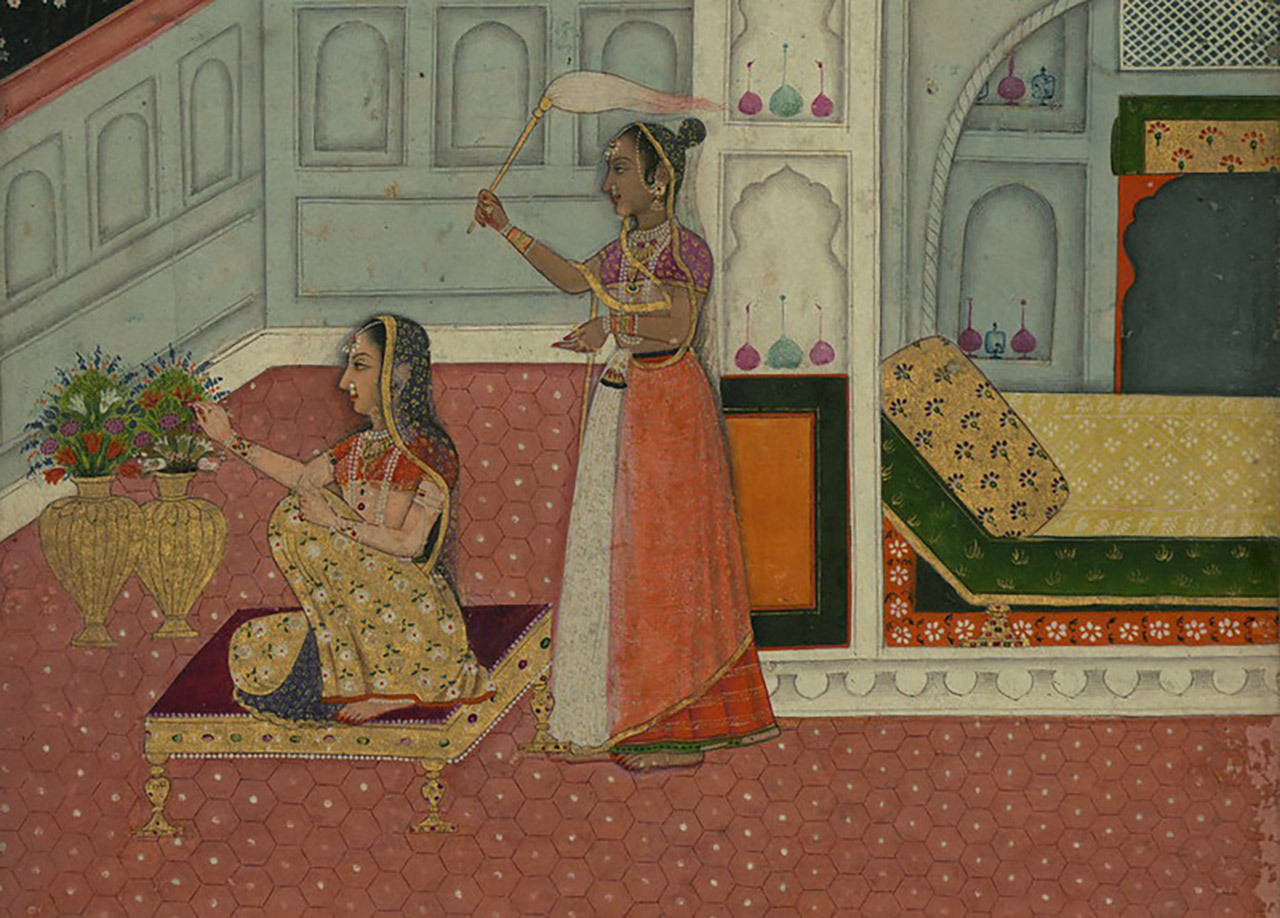
India has a very rich culture and tradition and it portrays it through its amazing art and craft. In India, Every region and state is linked with a particular art form like the Madhubani painting in Bihar to the Pithora painting in Gujarat, the Warli painting in Maharashtra, the Kalamkari painting in Andhra Pradesh, and Telangana to the Gond art in Madhya Pradesh. There are many folk art forms of India which have been internationally recognized and highly praised. We express our feelings, emotions, thoughts and admire our surroundings, nature, flora, and fauna, and respect our deities and mythology through these art forms. Let’s take a look at some of the types of Indian paintings:
1. Madhubani Painting
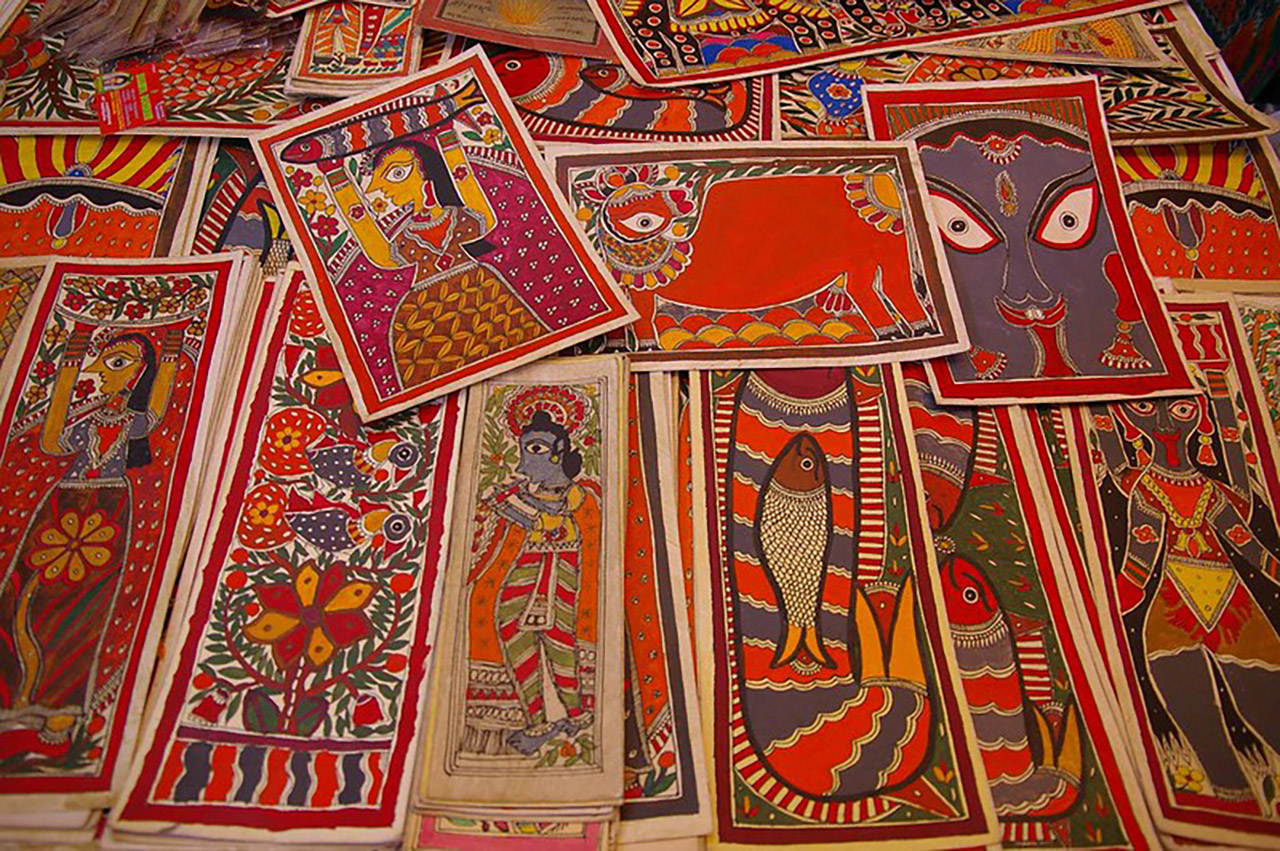
The Madhubani paintings or Mithila paintings originated in the Madhubani village of Bihar and are mostly created by women. This type of Indian painting uses many tools like fingers, twigs, brushes, nib-pens, matchsticks, and natural colors. These are done on walls, floors of holy places, canvases, etc. These brightly colored Madhubani paintings are characterized by their geometrical patterns and are widely practiced in the Madhubani district in Bihar. Originally, these paintings were done on mud walls and soil ground or floors. Now, they are also done on canvases, cloth, and handmade paper. It is one of the most celebrated and popular styles of folk painting in India.
The themes of Madhubani paintings are mostly scenes from nature like sun, moon, tulsi plants and scenes from mythology and Hindu deities like Krishna, Rama, Shiva, Durga, Lakshmi, Saraswati, etc. They also include Ardhanarishvara, court scenes, social events, and wedding scenes. The origin of this art form dates back to the Ramayana period when Raja Janak (Sita’s father) requested the villagers to decorate the whole village on the occasion of Prince Rama’s and Sita’s wedding. Many Madhubani artists received several awards such as the National award and Padma Shri making the art form famous and recognized.
2. Phad Painting
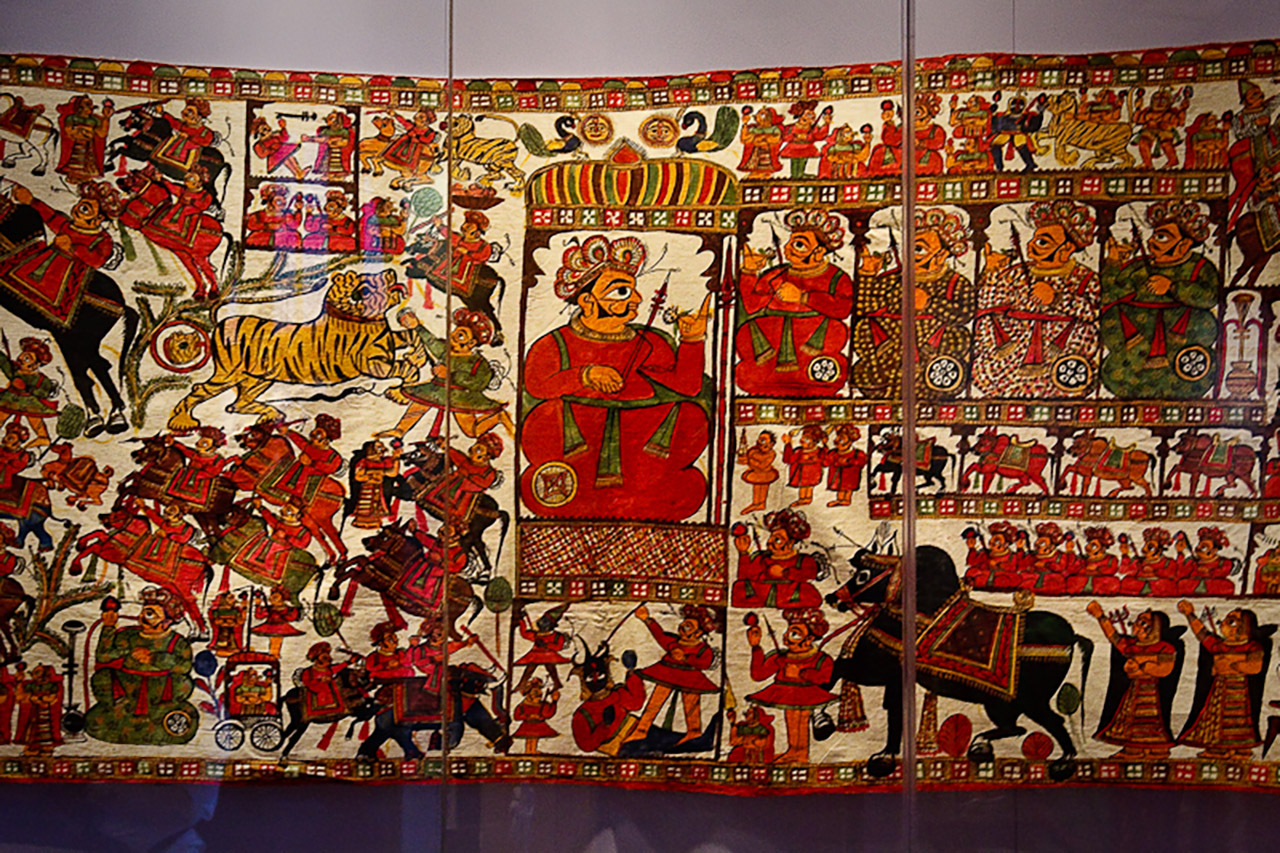
This type of Indian folk painting is practiced in the state of Rajasthan, India. Phad painting is a religious scroll painting style and traditionally done on a long piece of cloth or canvas which is known as Phad. Phads depict the folk deities of Rajasthan, mainly Pabuji and Devnarayan. The Bhopas, priest-singers of the folk deities in Rajasthan carry and perform in front of a Phad using it as a portable temple. It is a narrative scroll painting tradition on which stories of their deities and heroes like Prithviraj Chauhan are painted in mostly red, yellow, and orange colors.
Phad paintings depict battlefields, adventures, romance, etc. These paintings are very detailed and artists manage to accommodate many stories at once using every inch of the canvas. The Joshi community extensively practiced the Phad art form and later Shree Lal Joshi, a world-renowned Phad artist, and Padma Shree as well as Shilpguru award winner, who preserved and modernized this style, opened a school ‘Chitrashala’ for everyone to learn and practice the art form.
3. Warli Painting
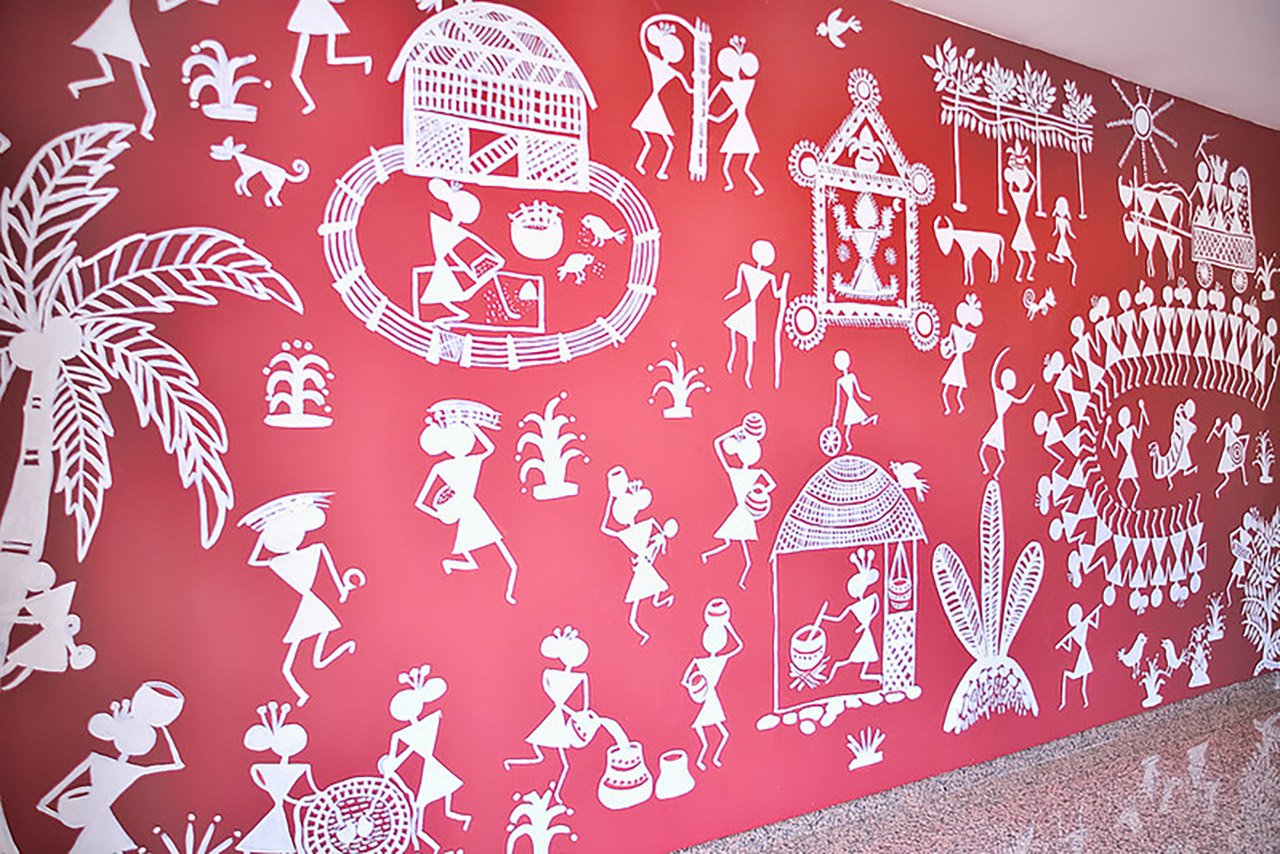
This form of tribal art belongs to one of the major tribes, the Warlis, in Maharashtra. It has been practiced for over 2500 years. It mostly depicts the daily activities of the local people such as farming, dancing, praying, hunting, sowing, etc., and the elements of nature. These paintings focus on showing social and daily life. They are closely connected to nature rather than showing mythological characters and deities.
Warli paintings are traditionally done on the mud walls of huts using twigs with rice paste. These paintings are characterized by white-colored, simple geometric designs and patterns like triangles, squares, and circles. Mountains and pointed trees are represented by a triangle, human inventions by square. The sun and moon are represented by the circle. The circular patterns also represent their belief that death is just another start. The central motif of a Warli painting is their Mother Goddess, Palaghat, who is their symbol of fertility. A marriage cannot take place without the sacred Warli paintings that represent Palaghat. These paintings are now also done on canvas, paper, and cloth and have become very popular. Jivya Soma Mashe, a renowned Indian artist and a
legendary Warli artist made the art form popular. He was awarded the Padma Shri in 2011 for his contribution towards Warli painting.
4. Kalamkari Painting
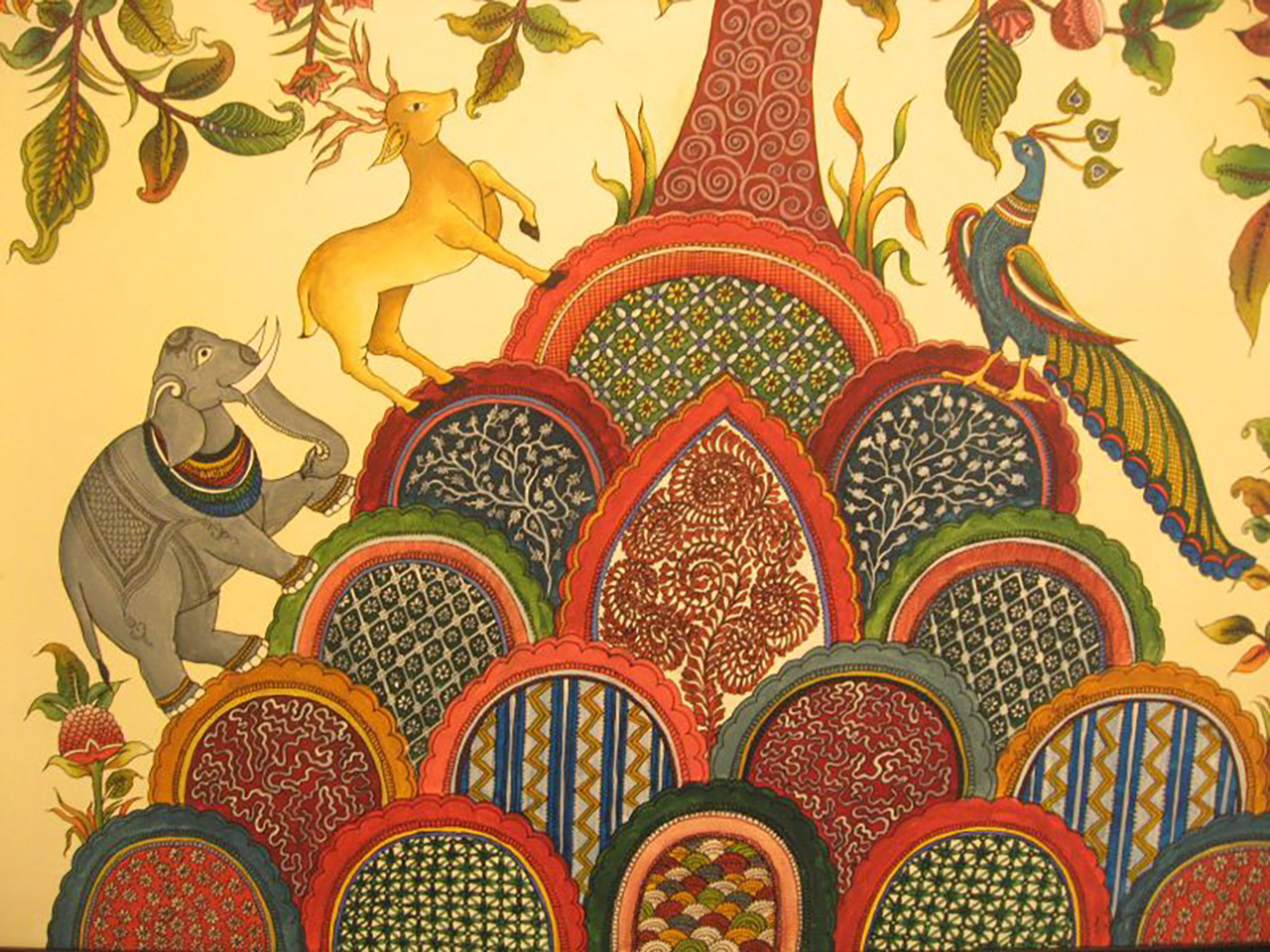
Derived from the words “Kalam” meaning pen and “Kari” meaning craftsmanship, the Kalamkari art form is practiced by many families and people in Andhra Pradesh and some villages in Tamil Nadu. Kalamkari usually depicts scenes from epics like Ramayana and Mahabharata, musical instruments, animals, Buddha and Buddhist art, flowers, and Hindu symbols like swastika. Kalamkari is an organic hand-printing or block-printing Indian folk art form which has been practiced for over 3000 years. The painting is done using a Kalam or a bamboo reed on fabric and natural and earthy colors and vegetable dyes are used like indigo, green, rust, black, and mustard. It is generally done on cotton fabric and it involves a twenty-three steps process. The Kalamkari art form is widely used on sarees and ethnic wear and is very popular.
5. Gond Painting
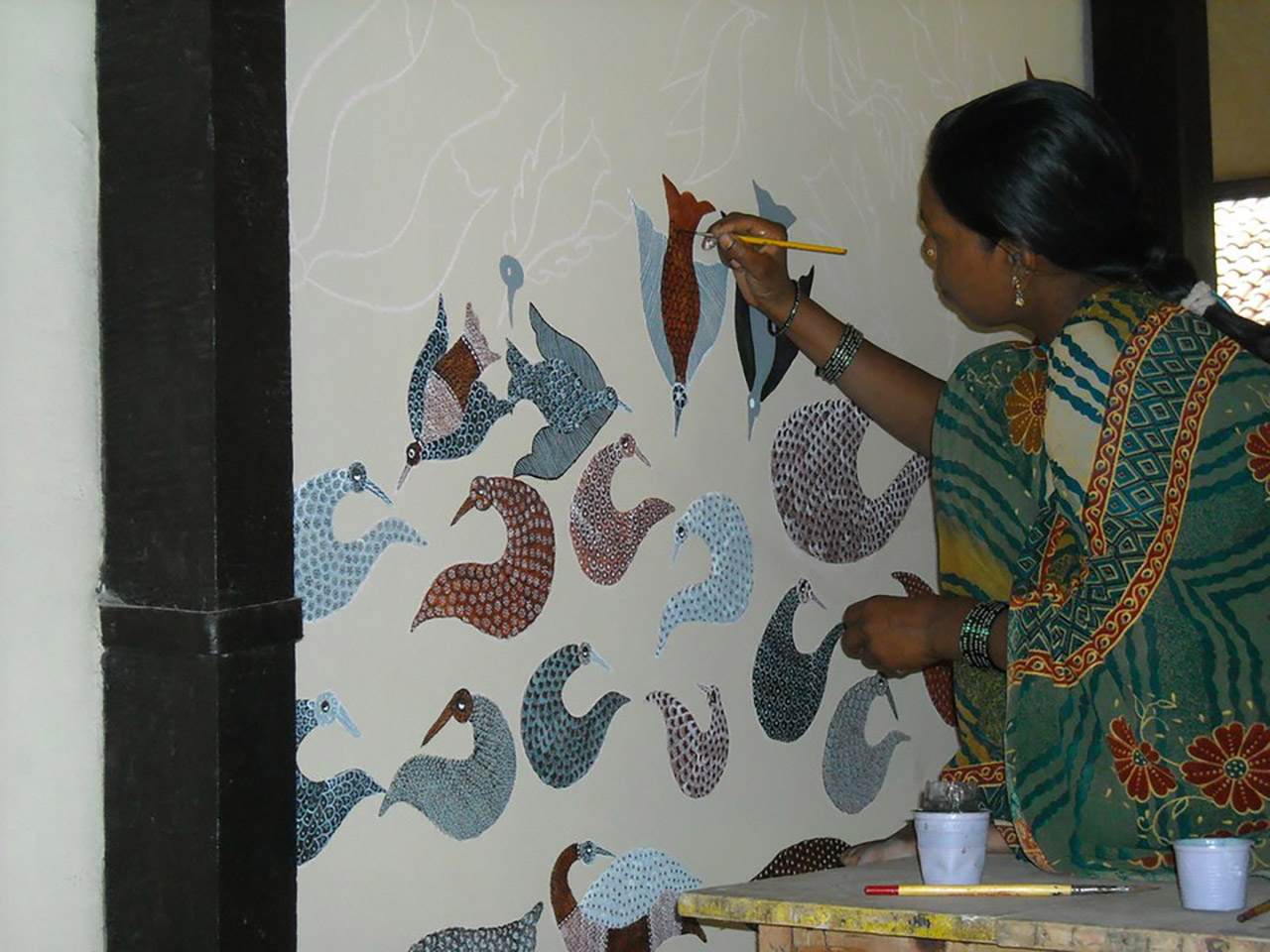
This art form is Indian folk and tribal art. They are practiced by the people of the Gond community in Madhya Pradesh. The word “Gond” has been derived from the Dravidian expression Kond meaning the green mountain. This art form has been practiced for over 1400 years. They usually depict flora and fauna, people’s daily lives, deities, festivals, and celebrations. They recreate mythological stories, nature, important occasions, and rituals. These are bold, bright, and vibrant paintings with very intricate work and rich detailing.
The Gond tribe is one of the oldest and the largest tribes in the country. Jangarh Singh Shyam, a Gond art legend and flagbearer of Gond art, made the art form so popular. He was the person who revived the art form and took it to new heights. He was also the first Gond artist to use canvas and paper for his work. He exhibited his painting internationally in museums thus making the art form internationally recognized and famous. Originally, the colors used in Gond art are derived from natural resources like cow dung, plant sap, charcoal, colored soil, mud, flowers, leaves, etc. But nowadays, artists use synthetic colors such as acrylic colors, watercolors, oil paints, etc. Some internationally acclaimed and celebrated artists who have contributed to this art form are Jangarh Singh Shyam, Bhajju Shyam, Venkat Shyam, and Durga Bai Vyam.
6. Patachitra Painting
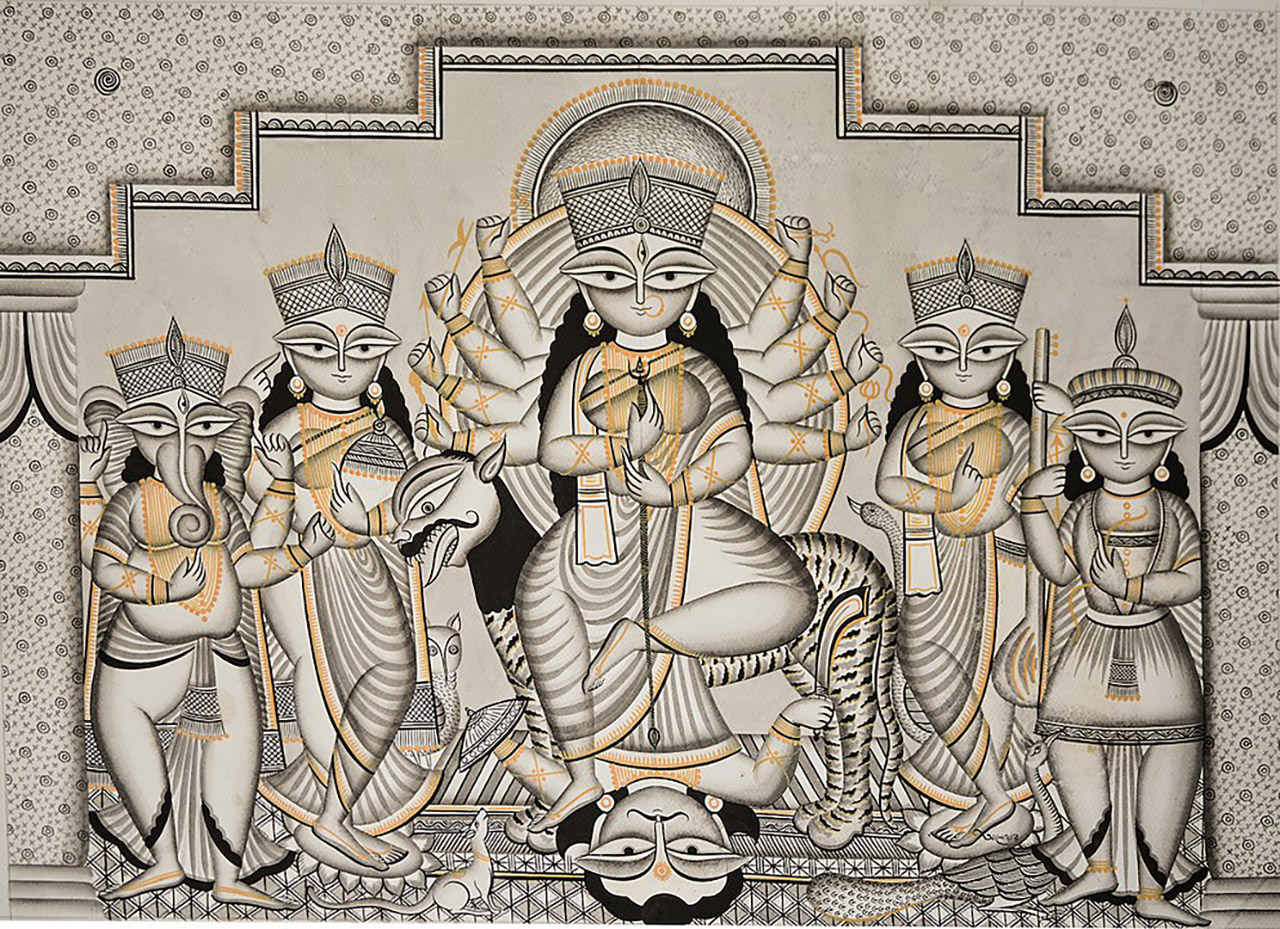
Patachitra or Pattachitra is a traditional, cloth scroll painting art form from the state of Odisha and West Bengal. The art form mainly depicts mythological and religious themes, epic, Hindu deities, etc. Thia Badhia – a depiction of the temple of Lord Jagannath, Krishna Lila – an enactment of Lord Jagannath as Lord Krishna displays his powers as a child, Dasabatara Patti – the ten incarnations of Lord Vishnu and Panchamukhi – Lord Ganesh’s depiction as a five-headed deity are some of the popular themes that are represented by the Patachitra art form. The word ‘Patachitra’ is derived from patta meaning cloth and Chitra meaning picture. The colors used are natural and vibrant like white, yellow, and red, and black with bold and strong outlines and decorative borders. The art form is being practiced for over 3000 years and the artists behind this art form are known as Mohapatras. One of the most renowned Patachitra artists was Raghunath Mohapatra, who was also awarded some of India’s highest civilian awards.
7. Tanjore Painting
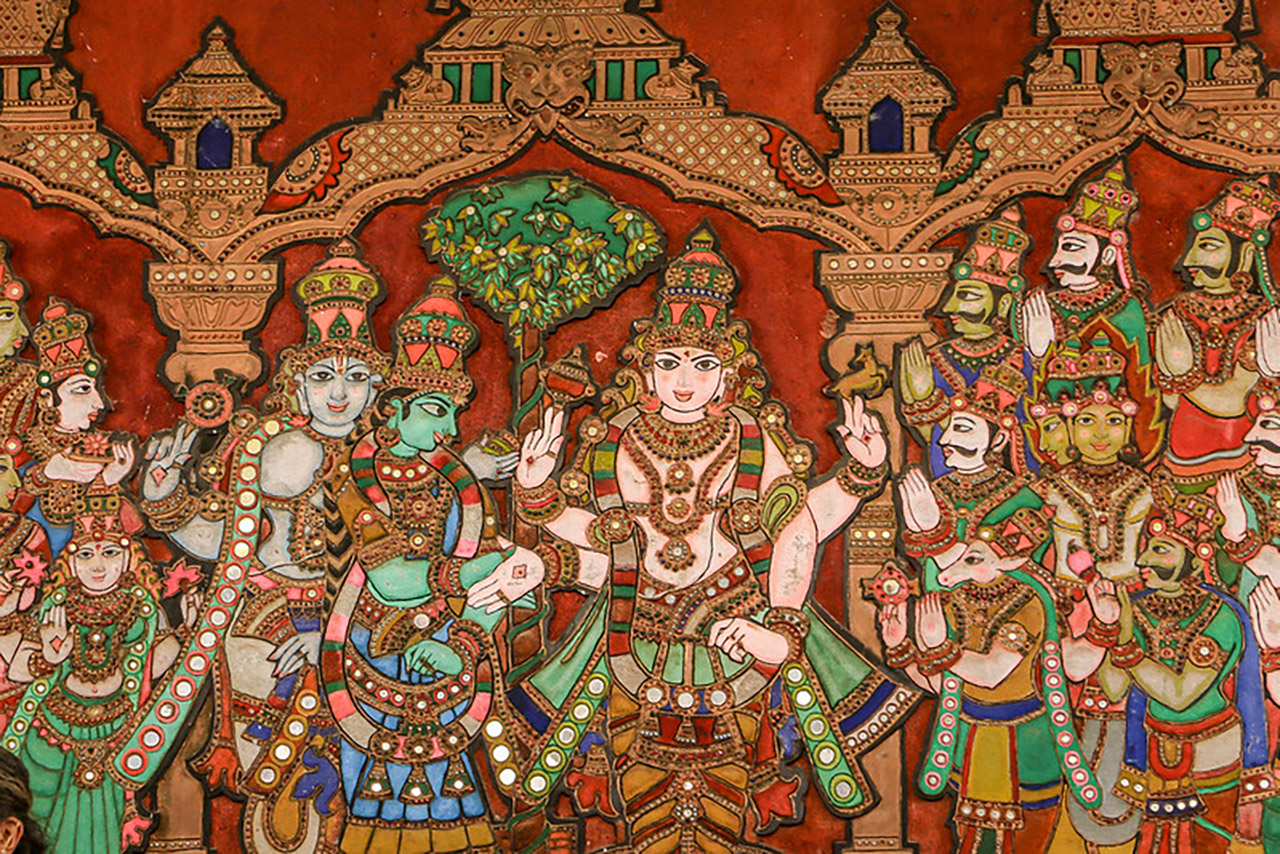
Tanjore or Thanjavur painting is an ancient Indian folk art form that originated in the town of Thanjavur in South India. It is a traditional South Indian painting style and it dates back to 1600 AD. These paintings are known for their use of gold foil which gives the painting a surreal look, the colorful panel painting done on a wood plank and a deity being the main theme of the painting, their use of semi-precious stones and vibrant colors. The main themes of the Tanjore paintings are Hindu deities, saints, scenes from Hindu Puranas, Sthala-Puranas and mythological, etc. These are panel paintings done on a wooden plank which is why they are also known as “palagai Padam” meaning “picture on a wooden plank”. An amazing fact about Tanjore paintings is that the shine of the gold leaves which are used in these paintings last forever. Tanjore paintings are extremely beautiful and graceful.
8. Cheriyal Scrolls
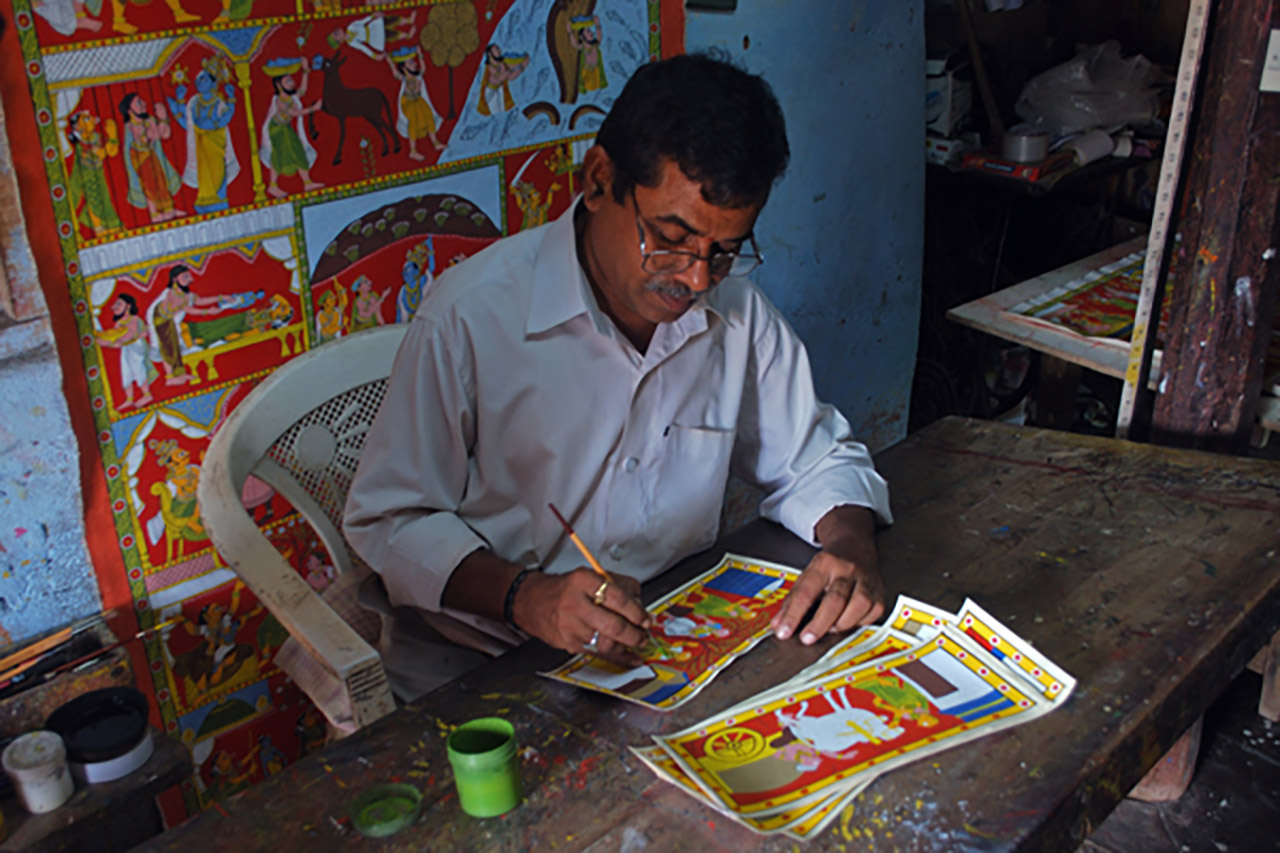
Cheriyal Scroll Painting style is a modified version of Nakashi art that originated in Telangana. Painted in a narrative format, these 40-45 feet scrolls mainly depict stories from Indian mythology, Puranas, and the Epics. These Cheriyal Scrolls are made on hand-woven khadi fabric. The canvas or the fabric is treated with a specially prepared solution and many coats are applied to it so that the canvas becomes stiff and it absorbs color increasing the lifespan of the painting. The colors used are made by the artists from natural sources and the brushes are made using the hair of squirrels tied to a stick. Some common themes of Cheriyal paintings are Krishna Leela, Ramayana, Mahabharata, Shiva Puranam,
and Markandeya Puranam. The art form is now practiced by only a few remaining families in the Cheriyal village in Telangana.
9. Kalamezhuthu
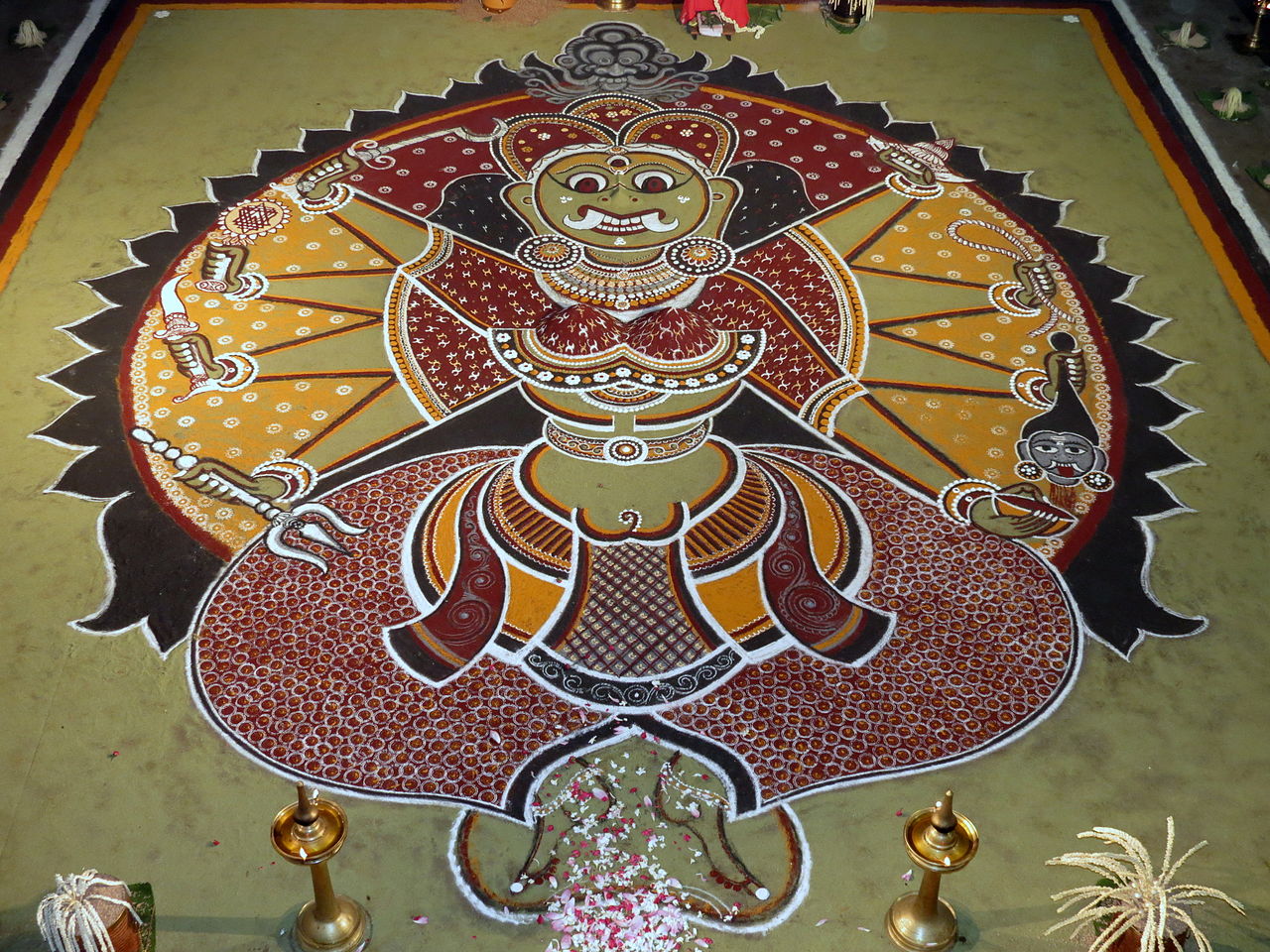
Kalamezhuthu is a traditional Indian and ritualistic art form practiced in temples and holy groves of Kerala. It is practiced as an offering for the blessings of gods and deities like Kali, Ayyappan, Bhadrakali, serpent god, etc. The illustrations of these deities are made on the floor using natural pigments and powders. Usually, five types of colored powders are used, white – rice flour, black – charcoal powder, yellow – turmeric powder, green – powdered green leaves, and red – a mixture of turmeric powder and lime. The artist draws using bare hands and the picture is first started from the center, developing outwards. Once the ‘Kalam’, which denotes the drawings or paintings made on the floor, is ready, the artist sings some ritual songs along with some instruments to worship the deity as a tradition. The ‘Kalam’ is started at a fixed time but is immediately erased once the rituals associated with it are over. Kalamezhuthu is a unique art form and the artists who practice it are
normally members of a community such as Kurups, Theeyadi Nambiars, and Theyyampadi Nambiars.
10. Mandana Art
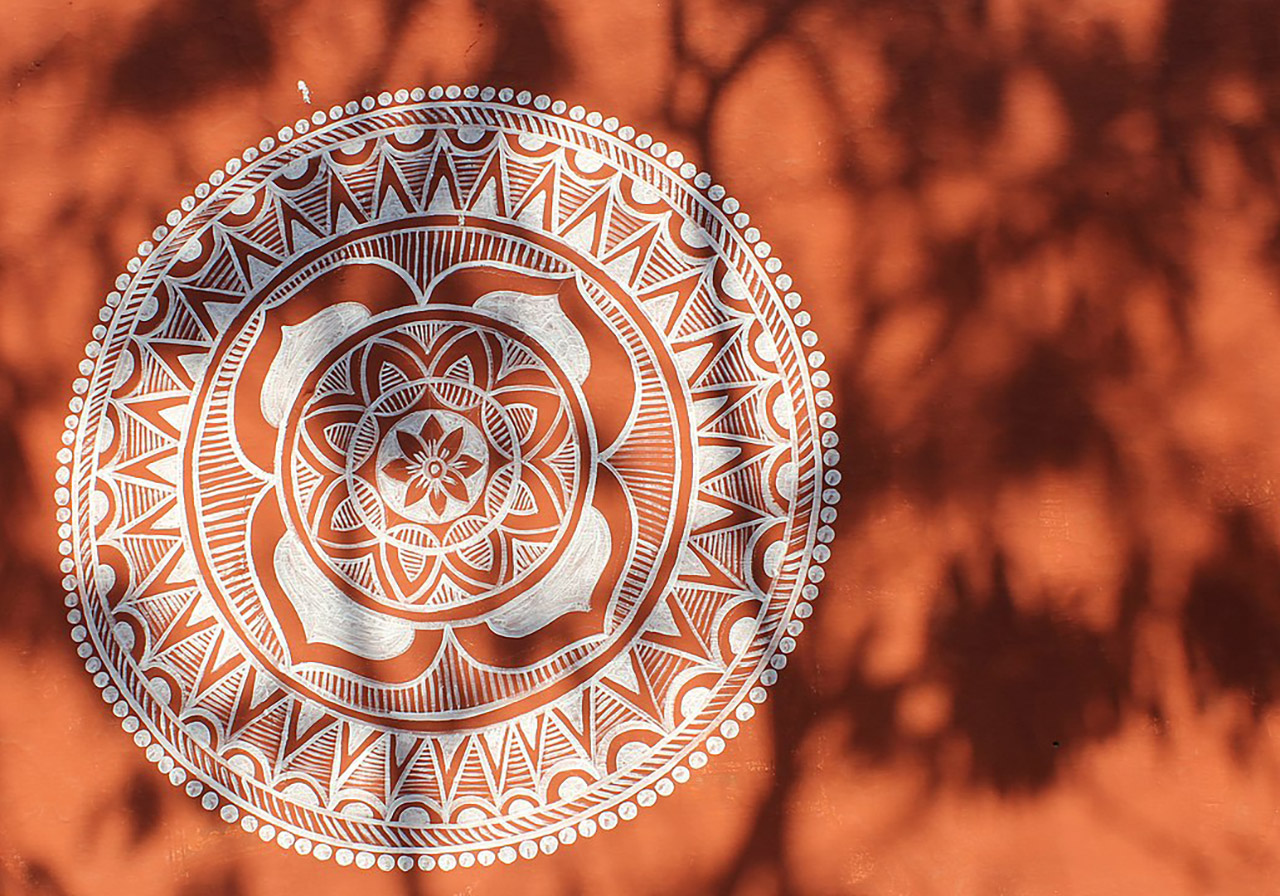
Mandana art form is decorative, tribal, and one of the oldest forms of Indian art. It is drawn on the walls and floors of houses in Rajasthan and Madhya Pradesh as a way to protect their home and fireplace. Mandanas are made to welcome gods and also on a festive occasion. The women of the Meena community in Rajasthan and Madhya Pradesh are the first Mandana artists. The Mandana paintings are very simple yet eye-catching. These paintings are made using a piece of cotton, twigs, a bunch of squirrel hair, and a simple brush made from a date stick. The base is prepared using cow dung mixed with rati (local clay), water, and red ochre. For making the motif, lime, brick, and chalk powder are used. Some basic designs of Mandana paintings are peacocks, tigers, floral, women working, Lord Ganesha, geometrical shapes, jaali, and Vedic yagna. The art form is dying and needs to find people who can keep it alive and help it regain its old popularity.
11. Rajput Painting
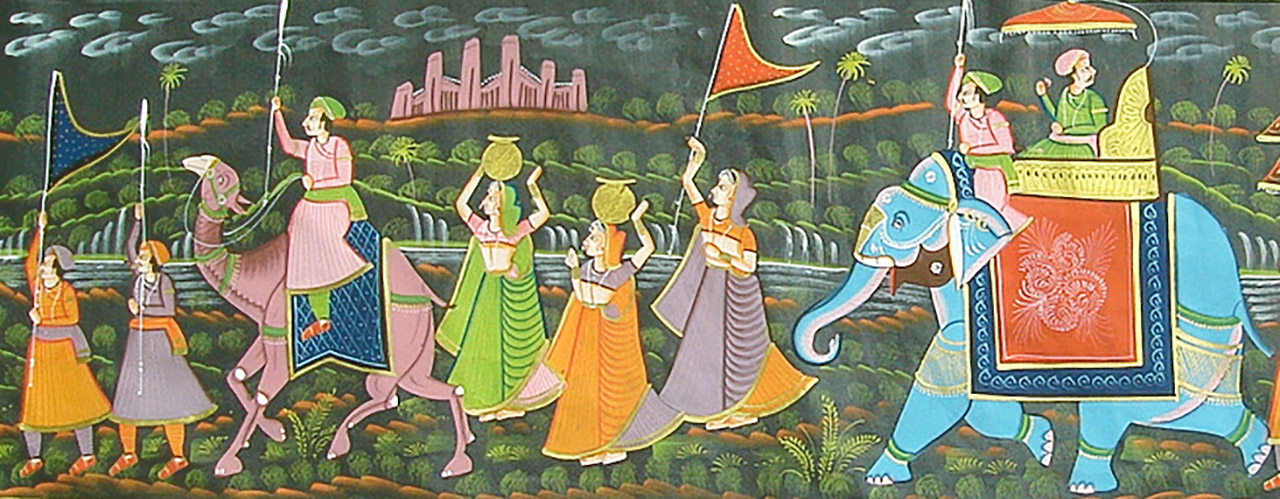
The Rajput paintings, also known as Rajasthani paintings, originated and flourished in the Rajputana royal courts in the state of Rajasthan around the 17th and 18th centuries. The main illustrations are the Hindu epics, Mahabharata and Ramayana, and scenes from Hindu mythology. The paintings are done with very minute details and bold colors. The colors used are extracted from minerals, plant sources, clams and shells, vegetables, and even from precious stones. Pure gold and silver were also used. The preparation of these colors took weeks and months and the brushes used are made from the hair of squirrels and are very fine. These Rajput paintings were mostly done on the walls of palaces, inner chambers of the forts, and Havelis. The Rajput paintings are of two styles: the Rajasthani style where the paintings are related to the Rajput courts in Rajasthan, and the Pahari style where the paintings are related to the Rajput courts of the Himalayan foothills.
12. Chittara Painting
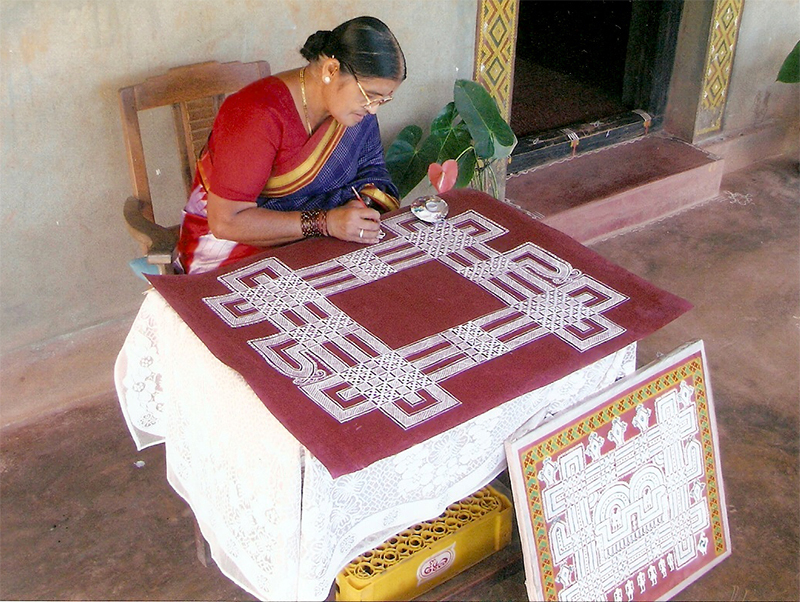
This Indian folk art form is practiced by the women of the Deewaru community in the Sagar district in Karnataka. The Chittara paintings are intricate wall paintings done using natural resources like rice paste and yellow seeds. The paintings are done on the walls and floors of their red-mud-coated village homes. These Chittara paintings generally depict the daily lives of tribal people, birds, and animals, flowers used for pooja, ceremonies, deities, socio-economic activities, toys that children play with, etc. The art form is now practiced by around five families in Karnataka and is on the verge of being extinct. The community that practices the art form makes its colors. They derive the colors from natural sources like rocks and stones, minerals, trees and vegetables, roasted rice, and the fine jute brush they use to paint are known as ‘Pundi’. The four main colors they use are white, red, black, and yellow. This traditional art form includes geometrical patterns and intricate designs and is generally drawn on auspicious occasions and ceremonies like marriage, housewarming, and festivals. There are 97 motifs among which some are named ‘Ele’, ‘Nili’, ‘Nili Kocchu’, ‘Basinga Nili’, and ‘Kalasa’. The Chittara painting is now also done on a range of artifacts and hand-made rice paper.
13. Saura Art
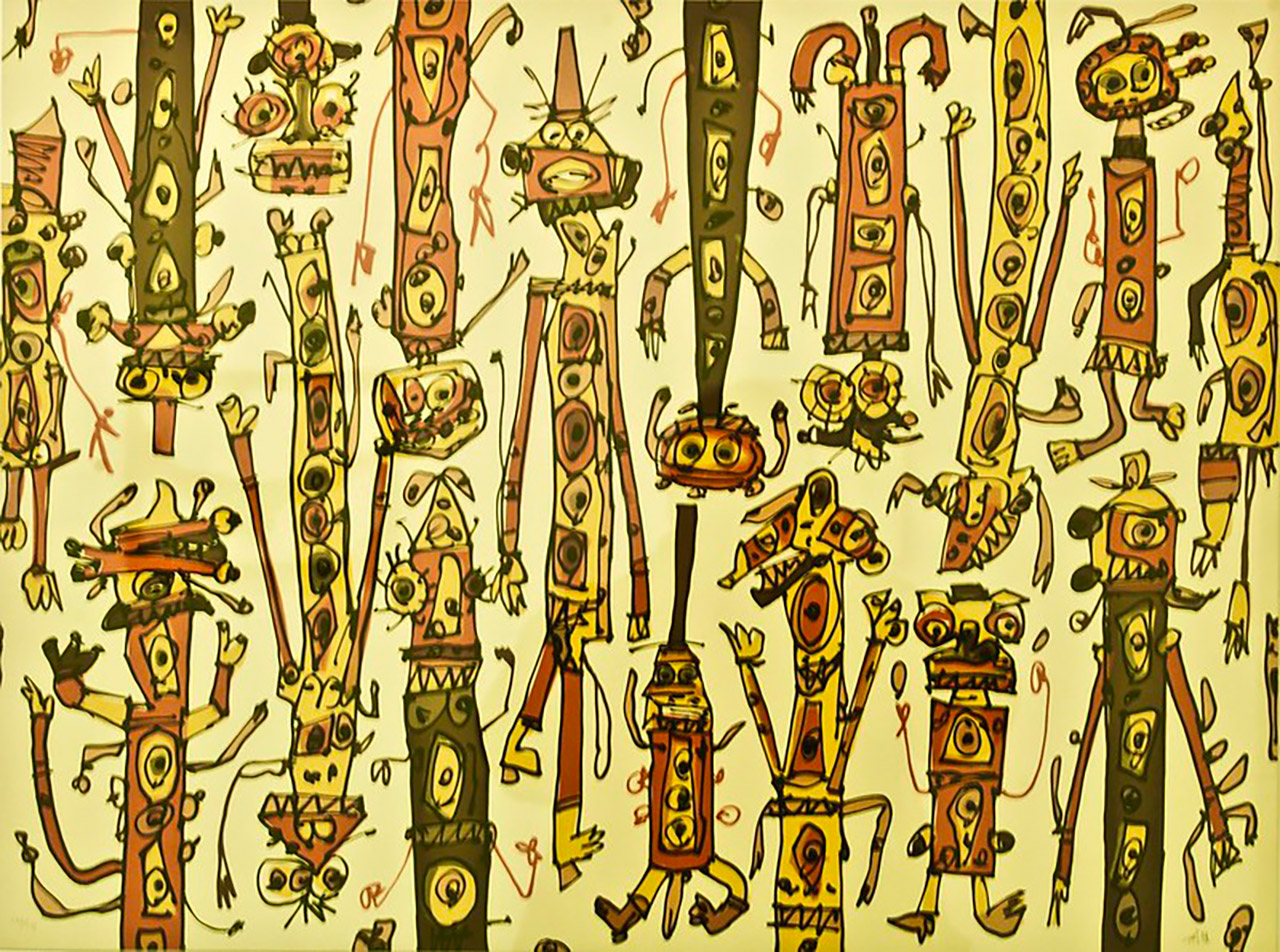
This tribal art form from the state of Odisha is a type of mural painting and is visually very similar to the Warli paintings. The Saura paintings are also known as ikons and are practiced by one of the most popular and ancient tribes of the country, the Saura tribe. These paintings are religiously important for them. These simple yet intricate drawings and paintings on the walls of village homes are dedicated to the main deity of the Sauras, Idital. Some common motifs are the sun, the moon, the tree of life, people, horses, and elephants. The base of these Saura paintings is prepared from red or yellow ochre and brushes used are created from tender bamboo shoots. Natural colors are used which are extracted from rice, white stone, hued earth, mixtures of tamarind seed, flower and leaf extracts, and finally, vermilion. The figures in Saura paintings are less angular, more elongated, and larger, the human body is shown by two sharp triangles and there is no physical difference between male and female shapes. Every Saura painting begins with a ‘fishnet’ approach and a border is drawn first after which the patterns, designs, and figures are drawn at the center. Nowadays, the art form is practiced on new mediums like canvas and paper and one can find Saura paintings on notebook covers, paintings, clothes, mobile covers, and sarees as well.
14. Bhil Art
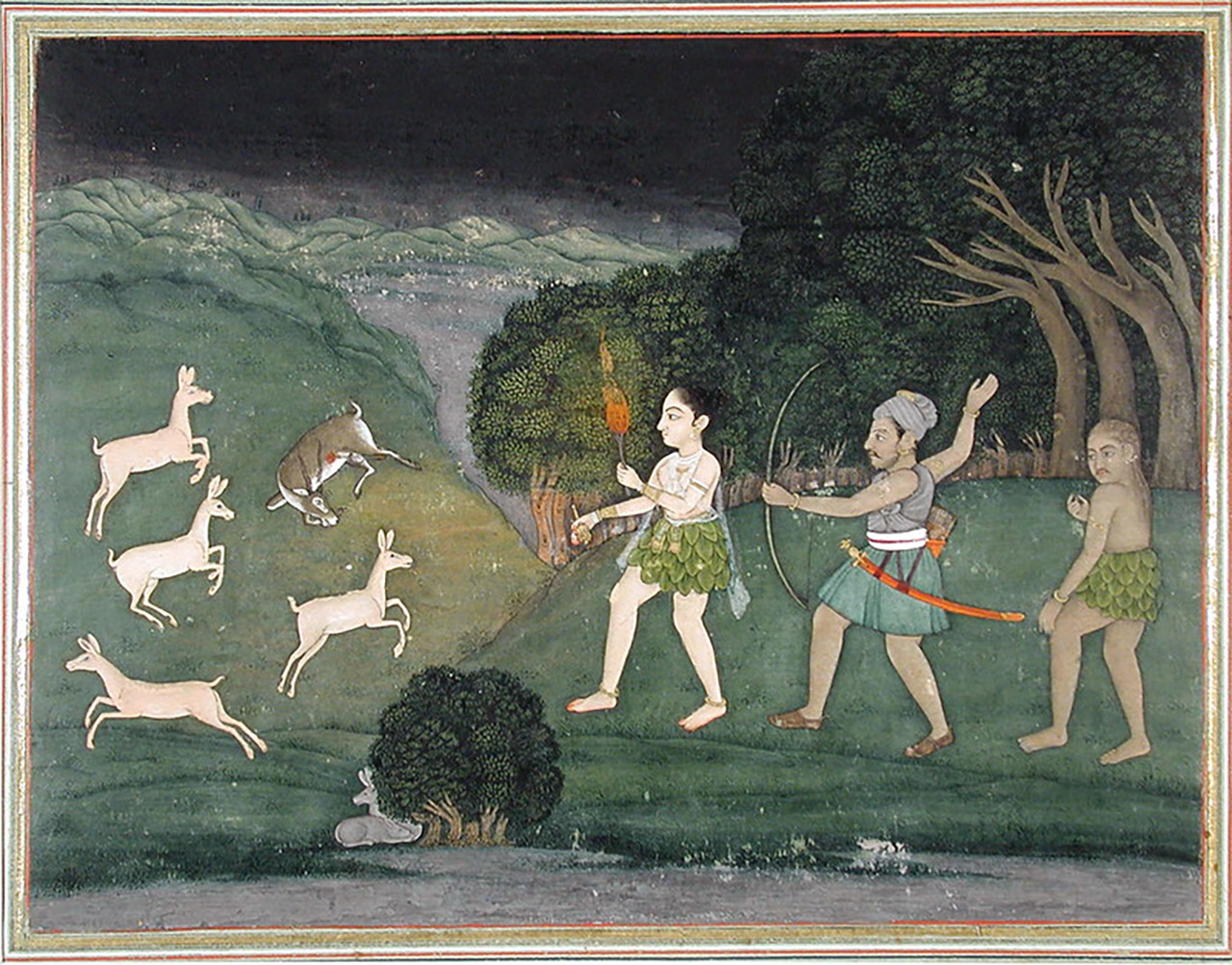
This is another tribal art form practiced by the second largest tribal community in India, the Bhils. The Bhils reside in Madhya Pradesh, Gujarat, Rajasthan, and Maharashtra and are highly superstitious people. Art is very important to them and the rich textures of their paintings connect their life to nature. The Bhil paintings are traditionally done on the clay walls of their village homes and neem sticks, twigs, and natural colors are used to do so. The bright and vibrant colors are extracted from turmeric, flour, vegetables, oil, and leaves. These Bhil paintings depict the everyday life of this tribe and they usually contain large shapes covered with uniform dots in numerous patterns and colors. These dots and patterns on a Bhil painting generally represent something that the artist wants like ancestors or deities. Some common depictions include nature, flora and fauna, Bhil deities, births and deaths, rituals, and festivals. Nowadays, this art form is practiced on a canvas
and acrylic paints are used instead of natural dyes.
15. Mysore Painting
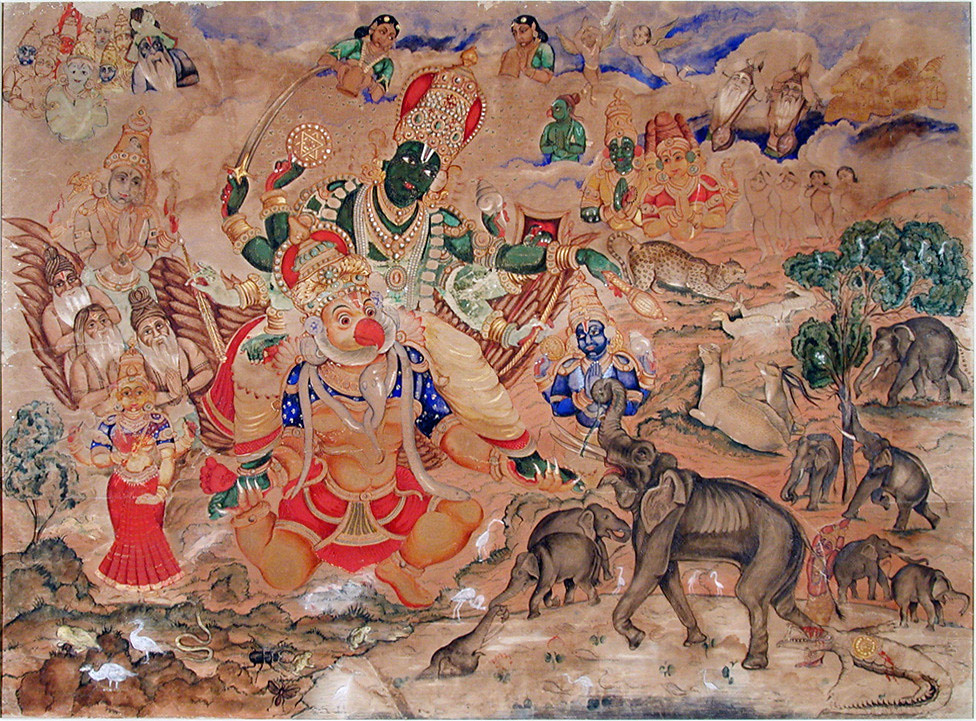
The Mysore painting has evolved in the Mysore city of Karnataka and employs thin gold leaves, similar to Tanjore Paintings. Hindu gods, deities and scenes from Hindu mythology form the most common themes of these paintings. A number of steps in the production of a Mysore painting are involved. The first phase involves the artist making an initial drawing of the picture on the base, with cartridge paper collected on a wooden basis. Afterwards, they make a paste, known as ‘gesso paste,’ of Zinc oxide and Arabic gum. The paste is utilised to produce a somewhat elevated carving appearance on those sections of the paint that require enhancements. The gold foil will then be attached to the surface. With the help of watercolours, the remaining painting is prepared. Once the paint is entirely dried, thin paper is used to cover and smoothly wiped with a soft stone. Artists employed colours of vegetables and minerals composed of diverse plant and mineral pigments and flowers. Brushes of various materials including squirrel, camel and goat’s hair were constructed and used. Grass blades have occasionally also been employed for drawing on sharp lines. Onlookers of this art style are often fascinated by its grace, beauty and complexity.
India’s great cultural diversity is vividly reflected in its vibrant art and craftsmanship. Different types of painting from different regions, each symbolising the tradition, customs and philosophies is transmitted from one generation to the next. Each one of these paintings is unique in beauty and style despite the shared themes of mythology and nature. These art forms, all fashioned out of natural dyes and colours, will transport you back in time and give you awe and appreciation for their rustic appeal.







Is mandana and mandla is same??
Nope!
From my understanding, ‘Mandala’ is specifically for paintings done in concentric forms, whereas ‘Mandana’ includes concentric art, but is not limited to it.
Hey Sam, thanks for updating us 🙂
No. Mandana is a traditional art form which is done on floor with the use of khadi, a white powder, dissolved in water and then used.
Mandala is modern form of painting done on paper, walls, doors etc.
Patachitra is only made in Odisha. There is no connection of Bengal. Please remove bengal from thr text.
Hey Smita, thanks for the feedback, Patachitra is also connected to Bengal. Please cross check.
Nice Article for collectors. Thanks for compiling this list.
Thanks Vamsi!
Really nice information ☺️💯♥️
Thanks Riya!
these information of paintings helped me a lot in my history project
Thanks!